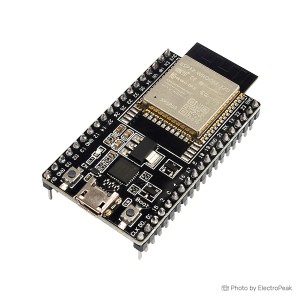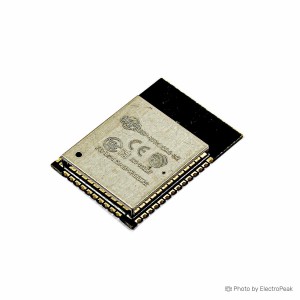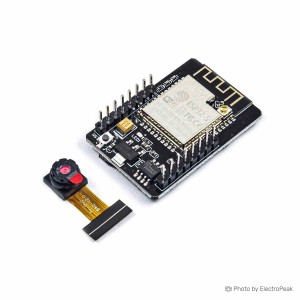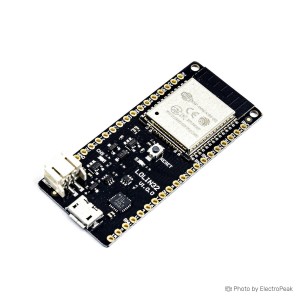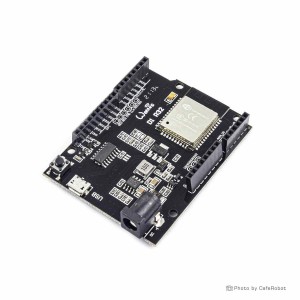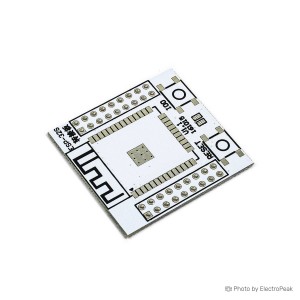ESP32
What is ESP32?
ESP32 is a powerful and versatile microcontroller, developed by Espressif Systems. It's part of the ESP family, known for its integration of Wi-Fi and Bluetooth capabilities. The ESP32 microcontroller offers a dual-core processor, onboard connectivity options, and a rich set of peripheral interfaces, making it an ideal choice for a wide range of IoT (Internet of Things) applications.
This compact yet feature-packed microcontroller is popular for its low power consumption, which is crucial for battery-operated devices. It supports both 2.4 GHz Wi-Fi and Bluetooth, making it suitable for various wireless communication needs. Whether you're a hobbyist or a professional developer, the ESP32 opens the door to creating innovative IoT projects, from home automation to sensor networks and beyond.
Price of ESP32
The cost of an ESP32 microcontroller can vary depending on several factors. These include the model, features, and whether you opt for an official board or a compatible clone. Official boards are typically priced slightly higher due to their quality and manufacturer support.
Clone boards, on the other hand, offer a more budget-friendly option. However, it's essential to be cautious when choosing a clone to ensure it meets your project's requirements.
Keep in mind that the overall expense of using an ESP32 for your project may also include accessories like sensors, power supplies, and breakout boards. These additional components can impact the overall cost but are crucial for creating a fully functional IoT or embedded system.
Buying ESP32
When it comes to buying an ESP32 microcontroller, there are a few key considerations to keep in mind. First, determine your project requirements. ESP32 comes in various models, each catering to different needs, from basic development boards to more specialized variants.
Next, check the availability of official and clone boards. While official boards are known for their quality and support, clones can be more budget-friendly. Be cautious when choosing a clone, ensuring it meets your project's specifications.
Consider your supplier. Reliable electronics stores and reputable online marketplaces are good sources for ESP32 boards. Read reviews and seek recommendations from the community to make an informed choice.
Finally, don't forget to look for accessories like power supplies, sensors, and breakout boards if your project demands them. This can simplify your setup and help you get the most out of your ESP32 microcontroller.
Popular Models of ESP32
The ESP32 microcontroller comes in various types, offering flexibility to cater to different project requirements. Some of the common variants include:
- Standard ESP32: This is the typical model featuring Wi-Fi and Bluetooth connectivity. It's suitable for a wide range of IoT applications
- ESP32-WROOM-32: A standard module with Wi-Fi and Bluetooth for diverse IoT applications.
- ESP32-CAM: Built for camera projects, featuring an integrated camera module.
- ESP32-S2: A power-efficient model with Wi-Fi, perfect for low-power and battery-operated devices.
- ESP32-S3: Offers enhanced security and AI capabilities for advanced applications.
- ESP32-WROOM: A compact module version ideal for space-constrained projects.
- ESP32-WROVER: Equipped with external PSRAM for data-intensive tasks.
- ESP32-PICO-D4: Compact and versatile, suited for a wide range of projects.
- ESP32-SOLO: Offers single-core performance for specific applications.
- ESP32-D2WD: A dual-core module for robust performance and connectivity.
- ESP32-WROVER-B: Comes with large PSRAM and Bluetooth support for complex IoT solutions.
- Custom Variants: Many manufacturers create custom ESP32 variants with added features or specialized functions
How much RAM and Flash Memory does ESP32 have?
Flash Memory in ESP32:
SPIFlash is a type of Flash memory used in ESP32 microcontrollers to store program code, data, and configuration information. It comes in various types and sizes to accommodate different needs. The most common SPIFlash options include Winbond, GigaDevice, and ISSI.
The available sizes for SPIFlash in ESP32 typically range from 1MB to 16MB. This variety allows developers to choose the right storage capacity for their specific applications. Some ESP32 variants also support external SPIFlash or other type for expanded storage.
PSRAM in ESP32 :
PSRAM, or Pseudo Static Random-Access Memory, is an additional memory component used in ESP32 microcontrollers to expand the available RAM. It provides extra storage for program execution and data handling, which can be crucial for applications demanding larger memory resources.
PSRAM in ESP32 comes in varying sizes to cater to diverse project needs, with common options being 4MB and 8MB. It's particularly useful for tasks like high-resolution image processing, data caching, and memory-intensive operations.
Difference between Arduino Boards and ESP and STM
When it comes to selecting the ideal microcontroller for your embedded systems or IoT project, Arduino, ESP (Espressif), and STM (STMicroelectronics) microcontrollers emerge as popular choices. Each of these platforms offers unique features, catering to a wide range of applications.
Arduino Microcontrollers:
Arduino IDE is the preferred programming tool, making it user-friendly and accessible. Known for their affordability, Arduino boards are suitable for diverse projects, providing moderate computational power and versatile clock speeds.
ESP (Espressif) Microcontrollers:
ESP microcontrollers, including the widely-used ESP8266 and ESP32, can be programmed using both the Arduino IDE and the advanced ESP-IDF (IoT Development Framework). They stand out for their cost-effectiveness, making them ideal for IoT projects. Designed for low to moderate power consumption, they are a solid choice for battery-powered IoT devices.
STM (STMicroelectronics) Microcontrollers:
Programming STM microcontrollers usually involves tools like STM32CubeIDE or STM32CubeMX or Keil MDK, which offer comprehensive support. While STM boards are generally priced higher, some models can utilize the Arduino IDE, providing more versatility. STM microcontrollers are distinguished by their high computational power and variable clock speeds. However, their robust performance may result in higher power consumption, making them better suited for non-battery-powered applications. STM excels in complex and resource-intensive projects.
In summary, your selection of microcontroller should be guided by your project's specific requirements, budget considerations, and power efficiency needs. Whether you choose the simplicity of Arduino, the cost-effectiveness of ESP, or the high performance of STM, picking the right microcontroller is pivotal to the success of your development process.
Difference Between CP2102 and CH340 on ESP32
CP2102 and CH340 are two commonly used USB-to-serial converter chips with ESP32 microcontrollers. While both serve a similar purpose of enabling USB connectivity, they have some distinctions:
Vendor: CP2102 is produced by Silicon Labs, and CH340 is manufactured by WCH (WCH CHIPS).
Driver Support: CP2102 often has better driver support across various operating systems, making it easier to install and use.
Compatibility: CH340 is generally more budget-friendly, but it may require manual driver installation on some platforms.
Community Preference: CP2102 is favored by many developers due to its reliability and widespread use, while CH340 is a cost-effective alternative.
Voltage Levels: CP2102 supports 3.3V and 5V logic levels, while CH340 mainly operates at 3.3V.
Choosing between CP2102 and CH340 depends on your specific project needs and driver compatibility with your target platforms.
What programming languages can be used with ESP32?
Developers can write code for the ESP32 in C/C++, MicroPython, and Arduino IDE. This flexibility enables a broad spectrum of developers, from those comfortable with low-level languages to those who prefer a simplified IDE.
Can I use the Arduino IDE for ESP32 programming?
Yes, the , making it accessible to a wide audience. The Arduino IDE simplifies programming and offers a supportive ecosystem for both newcomers and experienced developers. For more information on how to install ESP32 with the Arduino IDE, click here.
What are the power requirements for ESP32?
The ESP32 typically operates at 3.3V. In general, you should use a linear regulator to power up the ESP32. This allows you to use a range of linear regulators to provide power. Keep in mind that power requirements can vary depending on the specific ESP32 variant and the power needs of your .
What is the maximum clock speed of ESP32?
The ESP32 can be configured to run at different clock speeds, with a maximum clock speed of 240 MHz, ensuring high performance for various applications.
What are the GPIO pins on ESP32, and how do I use them?
ESP32 provides a wide array of General-Purpose Input/Output (GPIO) pins, offering the flexibility to handle input, output, and other functions. This adaptability makes it suitable for diverse projects. Read more on ESP32 Pinout reference here.
Is ESP32 compatible with 3.3V and 5V logic levels?
The ESP32 primarily operates at 3.3V logic levels but can be used in conjunction with 5V systems with appropriate voltage level shifting components to ensure compatibility.
What is the maximum data transfer rate for Wi-Fi and Bluetooth on ESP32?
ESP32 can achieve data transfer rates of up to 150 Mbps for Wi-Fi and 3 Mbps for Bluetooth, depending on the specific version and usage.
However, real-world data transfer rates can often be lower due to factors such as interference and signal strength.

